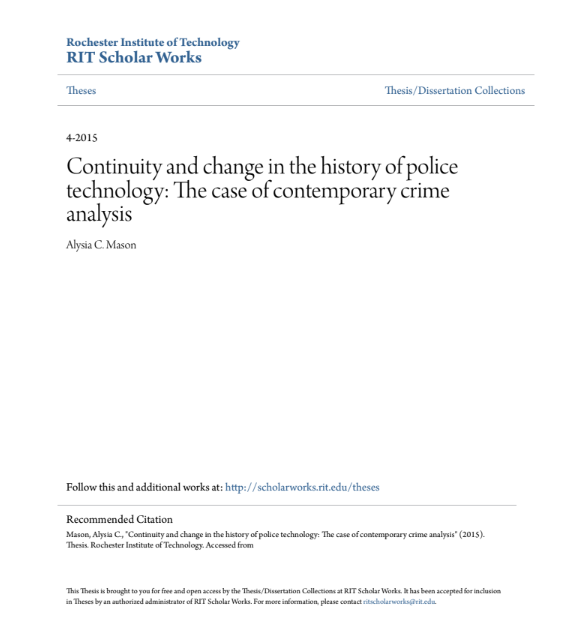Continuity and change in the history of police technology: The case of contemporary crime analysis by Alysia C. Mason

| Title | Continuity and change in the history of police technology: The case of contemporary crime analysis by Alysia C. Mason |
| Author | Alysia C. Mason |
| Overview | Overview of “Continuity and Change in Police Technology” The article “Continuity and Change in Police Technology” explores the evolution of police practices and technologies over time, tracing their development from the early days of policing to the modern era. The authors examine how technology has influenced police work, offering historical context for its integration into law enforcement and assessing current trends and challenges in adopting advanced technologies. The study draws on three interrelated research projects, each offering unique insights into the role of technology in contemporary policing and crime analysis. Crime Analysis and Technology Crime analysis, as defined in the article, is the systematic use of data and police knowledge to combat and solve crime. It involves employing technological tools to identify patterns, predict crime trends, and enhance police efficiency. The authors highlight that police technology includes not only physical tools, such as computers, but also data processing systems that allow officers to collect, analyze, and share information effectively. The article emphasizes that the purpose of technology in policing is not just to solve crimes but also to prevent them by providing law enforcement agencies with timely and relevant data. The article builds its foundation by presenting the historical evolution of technology in law enforcement. In the early days of policing, during the 1700s, law enforcement officers, known as watchmen, used very rudimentary tools like double reed wood rattles to alert the community to danger. These tools, though primitive by modern standards, played a vital role in early crime prevention and control. Watchmen were not outfitted with uniforms or advanced equipment, but they had identifiers like green lanterns that marked their posts. As industrialization grew in the United States, the need for more organized and effective policing became apparent. By the mid-19th century, the increasing urban population and rise in visible crime, such as mob violence and prostitution, strained the traditional constable-watch system. Modern police departments began forming in major cities like New York, St. Louis, and Chicago as a response to social disorder. These early police forces were influenced by the English model, which emphasized limited authority, local control, and fragmented law enforcement authority. While these principles laid the groundwork for modern policing, they also introduced challenges, such as communication and cooperation issues among different police agencies. Historical Context of Police Technology The article explains that as police departments evolved, so did the tools and methods they employed. In the early stages of police technology adoption, officers were reluctant to embrace changes such as wearing uniforms or carrying weapons. Uniforms were introduced as a way for the public to easily identify officers, despite initial resistance from officers who feared ridicule and becoming targets for violence. Boston and Chicago were among the first police departments to issue uniforms in the late 1850s, with Boston eventually becoming the first department to officially arm its officers with pistols in 1868. The political era of policing, which followed the establishment of police departments, saw officers appointed by politicians, often with little to no formal training or standards for hiring. The article discusses August Vollmer, a key figure in police reform, who advocated for better training, higher standards, and the professionalization of the police force. Vollmer’s work laid the groundwork for the modern police training programs and the development of more efficient policing practices. Modern Crime Analysis and Contemporary Research The article also delves into contemporary crime analysis practices, drawing on three research projects to explore how modern police organizations are adopting technology. The first project examines the implementation of community problem analysis, a method that focuses on understanding and addressing the root causes of crime within a community. This approach integrates technology to provide data-driven insights that help police respond to community-specific challenges. The second project explores the use of listservs by crime analysts. These online forums allow analysts to share knowledge, seek professional assistance, and discuss best practices. This highlights how technology not only aids in crime-solving but also fosters collaboration among law enforcement professionals, further enhancing their ability to combat crime. The third project surveys crime analysts from New York State to understand their training needs and experiences. The findings indicate that while analysts play a critical role in modern policing, there is a growing demand for better training and professional development opportunities. This reflects the ongoing evolution of crime analysis as a profession, with increasing recognition of its importance in law enforcement. Conclusion The article concludes by emphasizing that while the role of technology in policing has evolved significantly, challenges remain, particularly in terms of adoption and implementation. Law enforcement agencies must continue to adapt to technological advances and invest in the training and development of their officers and analysts. The study suggests that future research should explore new avenues to enhance crime analysis and further professionalize this emerging field, ensuring that law enforcement agencies remain effective in the face of evolving criminal threats. |
| Download Link | click here to download |